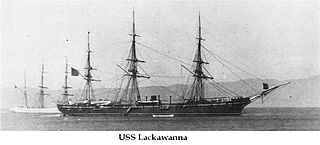
USS Brooklyn was a sloop-of-war authorized by the U.S. Congress and commissioned in 1859. Brooklyn was active in Caribbean operations until the start of the American Civil War at which time she became an active participant in the Union blockade of the Confederate States of America.

USS Katahdin was a Unadilla-class gunboat built for the U.S. Navy during the American Civil War.

The first USS Rhode Island was a side-wheel steamer in the United States Navy, commissioned in 1861.
USS New London was a screw steamer of the Union Navy during the American Civil War. She was outfitted with a Parrott rifle and 32-pounders, and was assigned as a gunboat in the Union blockade of the Confederate States of America.

USS Richmond was a wooden steam sloop in the United States Navy during the American Civil War.

USS Sciota was a Unadilla-class gunboat built on behalf of the United States Navy for service during the Civil War. She was outfitted as a gunboat, with both a 20-pounder rifle for horizontal firing, and two howitzers for shore bombardment, and assigned to the Union blockade of the waterways of the Confederate States of America.

The first USS Lackawanna was a screw-propelled sloop-of-war in the Union Navy during the American Civil War. She was named after the Lackawanna River in Pennsylvania.

USS South Carolina was a steamer used by the Union Navy during the American Civil War.

The first USS Ossipee was a wooden, screw sloop-of-war in commission in the United States Navy at various times between 1861 and 1889. She served in the Union Navy during the American Civil War. She was named for the Ossipee River of New Hampshire and Maine. The USS Ossipee was present during the Alaska Purchase.

USS Albatross was a screw steamer rigged as a three-masted schooner acquired by the Union Navy during the beginning of the American Civil War. She was outfitted as a gunboat with heavy guns and used in the Union blockade of the waterways of the Confederate States of America.
USS Henry Janes was a mortar schooner acquired by the United States Navy during the American Civil War. She was used as a gunboat and assigned to the blockade of ports of the Confederate States of America.

USS Owasco was a Unadilla-class gunboat built for the Union Navy during the American Civil War. She was named for Owasco Lake.
The second USS Kensington was a steamship in the United States Navy.
USS Rachel Seaman was a wooden schooner purchased by the Union Navy during the American Civil War.
USS Itasca was a Unadilla-class gunboat built for the U.S. Navy during the American Civil War. She was used by the Navy to patrol navigable waterways of the Confederacy to prevent the South from trading with other countries.

USS Morning Light was a sailing ship acquired by the Union Navy during the American Civil War. She was used by the Navy to patrol navigable waterways of the Confederacy to prevent the South from trading with other countries.
USS William G. Anderson was a barque used by the Union Navy during the American Civil War. She was assigned by the Navy to patrol navigable waterways of the Confederacy to prevent the South from trading with other countries.
USS Magnolia was a steamer captured by the Union Navy during the American Civil War. She was planned to be used by the Union Navy to patrol navigable waterways of the Confederacy to prevent the South from trading with other countries.
USS Kittatinny was a schooner originally named Stars and Stripes, which was acquired by the Union Navy during the American Civil War. She was used by the Union Navy as a gunboat in support of the Union Navy blockade of Confederate waterways.
The third USS Virginia was a 581-ton blockade-running steamer captured by the United States Navy and put to use during the American Civil War. Virginia served the U.S. Navy primarily as a mortar gunboat. Her ordnance included six 24-pounder howitzers and a 12-pounder rifled gun.












